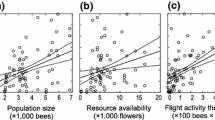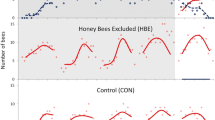Summary
Flight patterns of honeybees (Apis mellifera ligustica) were quantified as the bees foraged among artificial ‘flowers’ for sugar solution (‘nectar’). Bees exhibited considerable directionality on successive flights which minimized repeat visits to flowers and they usually made short flights to nearby flowers, thus minimizing flight time. The change in direction on successive flights between flowers were independent of the number of immediately preceding consecutive rewarding visits but decreased as the number of non-rewarding visits increased. Flight distances were short after visits to rewarding flowers but increased as the number of immediately preceding non-rewarding visits increased. The bees' rate of caloric intake (calories/time) was highest at the floral arrays having the highest density, and it was greater at arrays with clumped nectar-distributions than at those with randomly distributed nectar. These findings are explained in terms of the observed flight patterns.
Similar content being viewed by others
References
Baker, M.C.: Foraging behavior of black-bellied plovers (Pluvialis squatorola). Ecology55 (1), 162–167 (1974)
Banks, C.J.: The behaviour of individual coccinellied larvae on plants. British J. Anim. Behav.5, 12–24 (1957)
Batschelet, E.: Statistical methods for the analysis of problems in animal orientation and certain biological rhythms. Mon. Amer. Inst. Biol. Sciences, Washington, D.C. (1965)
Beukema, J.J.: Predation by the three-spined stickleback (Gasterosteus aculeatus): the influence of hunger and experience. Behaviour31, 1–126 (1968)
Carpenter, F.L.: Plant pollinator interactions in Hawaii: pollination energetics ofMetrosideros collina (Myrtaceae). Ecology57, 1125–1144 (1976)
Croze, H.: Searching image in carrion crows. Hunting strategy in a predator and some anti-predator devices in camouflaged prey. Z. Tierpsychol., Beiheft5, 1–86 (1970)
Dixon, A.F.G.: An experimental study of the searching behaviour of predatory coccinellid beetleAdalia decempunctata (L.). J. Anim. Ecol.28, 259–281 (1959)
Heinrich, B.: Energetics of pollination. Ann. Rev. Syst. Ecol.6, 139–170 (1975)
Laing, J.: Host finding of insect parasites. I. Observation of the finding of hosts byAlysia manducator, Mormoniella vitripennis andTrichogramma evanescens. J. Anim. Ecol.6, 298–317 (1937)
Levin, D.A., Kerster, H.W.: The dependence of bee-mediated pollen and gene dispersal upon plant density. Evolution23, 560–571 (1969)
Levin, D.A., Kerster, H.W., Niedzlek, M.: Pollinator flight directionality and its effect on pollen flow. Evolution25, 113–118 (1971)
Murdie, G., Hassell, M.P.: Food distribution, searching success and predator-prey models. In: Proc. Symp. Math. Theory Dynamics Biol. Popul. (M.S. Bartlett and R.W. Hiorns (eds.)), Academic Press, N.Y., pp. 87–101 1973
Pflumm, W.: Stimmungsänderungen der Biene während des Aufenthalts und der Futterquelle. Z. vergl. Physiol.65, 299–323 (1969)
Pyke, G.H.: Are animals efficient harvesters? Anim. Behav.26, 241–250 (1978a)
Pyke, G.H.: Optimal foraging: Movement patterns of bumblebees between influrescences. Theoret. Pop. Biol.13, 72–98 (1978b)
Smith, J.N.M.: The food searching behaviour of two European thrushes. I. Description and analysis of search paths. Behaviour48, 276–302 (1974a)
Smith, J.N.M.: The food searching behaviour of two European thrushes. II. The adaptiveness of the search patterns. Behaviour49, 1–61 (1974b)
Waddington, K.D.: Quantification of the movement patterns of bees: a novel method. Amer. Midl. Natur.,101, 278–285 (1979)
Waddington, K.D., Heinrich, B.: Patterns of movement and floral choice by foraging bees. In: Mechanisms of Foraging Behavior (A. Kamil and T. Sargent eds.), (In Press)
Author information
Authors and Affiliations
Additional information
Contribution number 1660 from the Department of Entomology, University of Kansas, Lawrence, Kansas 66045, USA
Rights and permissions
About this article
Cite this article
Waddington, K.D. Flight patterns of foraging bees relative to density of artificial flowers and distribution of nectar. Oecologia 44, 199–204 (1980). https://doi.org/10.1007/BF00572680
Received:
Issue Date:
DOI: https://doi.org/10.1007/BF00572680




